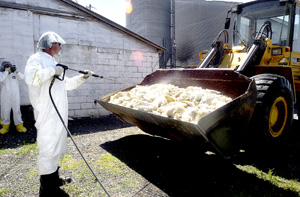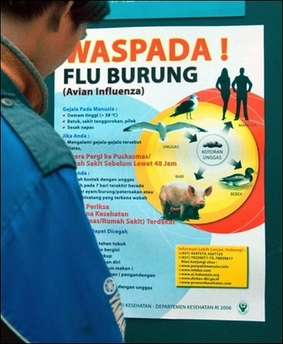Virginia's sick turkeys, blowflies, and an Indonesian mystery
 Well, the discovery that low-path H5N1 was present in a flock of some 54,000 turkeys in Virginia didn't seem to phase anyone. I should explain that low-path H5N1 is found in wild birds across the United States all the time. In fact, Delaware seems to be routinely testing and finding low-path H5N1 in wild birds (and maybe the WHO and OIE and FAO and the whole "alphabet soup gang" should simply outsource wild bird testing to Delaware?).
Well, the discovery that low-path H5N1 was present in a flock of some 54,000 turkeys in Virginia didn't seem to phase anyone. I should explain that low-path H5N1 is found in wild birds across the United States all the time. In fact, Delaware seems to be routinely testing and finding low-path H5N1 in wild birds (and maybe the WHO and OIE and FAO and the whole "alphabet soup gang" should simply outsource wild bird testing to Delaware?).
But finding LP H5N1 in wild birds and finding it in a Virginia turkey farm are two different things. And, as I have said over and over again -- if left untreated, low path bird flu goes in, and high path bird flu comes out. This reality has presented itself countless times in poultry farms across the nation and, indeed, across the world.
Recall that up until 2003, the world leader in avian influenza outbreaks among domestic poultry was -- drum roll, please -- the United States of America. As written in Dr. Michael Greger's excellent tome "Bird Flu: A Virus of Our Own Hatching," Greger presents a compelling argument that it might be the Delmarva Peninsula within the Delaware, Virginia and Maryland triangle, and not Guangdong, China or Jakarta, Indonesia, where a pandemic launches.
So you gotta love the comments from the United States Department of Agriculture's Dr. John Clifford, from USDA's National Veterinary Services Laboratories (from Reuters).
The turkeys had antibodies to a low pathogenic form of the H5N1 avian influenza virus, Clifford said. This strain of H5N1 does not usually make birds ill, although it could potentially change into a more dangerous form if allowed to spread.
"Every indication is that the virus detected is consistent with the North American strain of low pathogenic H5N1, which is not a human health concern," Clifford said in a statement.
"The turkeys showed no signs of illness, and there was no mortality. Thus far, there is no evidence the virus is actually present in the samples collected. The testing detected only antibodies, which indicate possible past exposure to the virus."
Allow me to translate this obviously encoded message. What he means is not "possible,' but "likely" exposure to the H5N1 virus, even if low-path. Turkeys do not get hatched with H5N1 in their veins. This means that a flock of 54,000 turkeys -- destined for the dinner tables of America and elsewhere -- had exposure to H5N1 enough to have produced antibodies. This means that very, very recently (remember, turkeys do not live very long, unless pardoned by the President at Thanksgiving), there was H5N1 on that farm. And the turkeys were exposed to it. According to statistics provided by animalaid.org, turkeys are slaughtered at 12 to 26 weeks, even though they may live to ten years of age. However, according to Website maguirefarm.com, turkeys bred for food usually cannot support their weight after a year. So, this means that sometime in the past 12 weeks to a year, low-path H5N1 was present in significant volume on the farm in question. And it got past the breeders and the State and Federal authorities. So it is possible that a low-pathogenic H5N1 could have entered this unnamed Virginia farm, circulated among the 54,000 birds, and its progeny could have been high-path H5N1. Now that is a sobering thought, that surveillance in the US missed this important development.
West Virginia, hit with its own heavily publicized low-path H5N2 outbreak just weeks ago, cancelled a poultry festival and is taking other steps to ensure the virus does not cross its border with Virginia. From an AP story in the Charleston Daily News:
Although the virus has not been found in West Virginia, the state Poultry Association decided Monday to cancel the five-day festival because area poultry farmers attending the festival might unwittingly transport the virus to other farmers, said Emily Funk, the association's executive secretary.
"When we have an avian outbreak like this we try not to get together," she said. "Try not to go to the grocery store. We try not to associate with each other."
"The festival is held in Moorefield, which will go ahead with its carnival and golf tournament for nonfarming residents. What will be missing are the beauty pageant and various education dinners and activities sponsored by the association, she said.
It's at least the second time since the 1980s that the festival has been canceled, she said.
State Agriculture Commissioner Gus Douglass said the low pathogenicity avian influenza found in a turkey flock in Mt. Jackson, Va., about 71 miles southeast of Moorefield, is not the same as the bird flu found in Southeast Asia, Europe and other countries.
Folks, the farmers do not associate with each other because they can shed virus from their clothing and shoes/boots, to be picked up by their neighbors -- and because they can also hypothetically be asymptomatic carriers of low-path H5N1.
 In another story, North Carolina State University reports that H5N1 can remain active in the stomachs of common houseflies for up to three hours. This study cited a 1985 study of housefly infestations with avian influenza stemming from 1983's huge H5N2 outbreak in Lancaster County, Pennsylvania. That study showed that more than a third of the houseflies trapped during the H5N2 outbreak had bird flu virus in their guts. Following a Kyoto, Japan outbreak of "bad" H5N1 in 2004, more evidence was collected to support the flies-as-vectors theory.
In another story, North Carolina State University reports that H5N1 can remain active in the stomachs of common houseflies for up to three hours. This study cited a 1985 study of housefly infestations with avian influenza stemming from 1983's huge H5N2 outbreak in Lancaster County, Pennsylvania. That study showed that more than a third of the houseflies trapped during the H5N2 outbreak had bird flu virus in their guts. Following a Kyoto, Japan outbreak of "bad" H5N1 in 2004, more evidence was collected to support the flies-as-vectors theory.
Nonetheless, nothing of consequence has been done to reduce or eliminate houseflies as a serious vector of avian influenza within the poultry industry.
Let me say that I know the masked R&B artist Blowfly personally and he is not responsible.
 Now, a quick look at the story coming out of Indonesia that a six year old boy who died of H5N1 was not exposed to poultry. That the story was broken by the Indonesian Agricultural Ministry is amazing. Here is an official organ of the Indonesian government admitting that this young lad had no exposure to poultry or wild birds -- but he did, apparently, go to the zoo recently. From a recent Reuters story:
Now, a quick look at the story coming out of Indonesia that a six year old boy who died of H5N1 was not exposed to poultry. That the story was broken by the Indonesian Agricultural Ministry is amazing. Here is an official organ of the Indonesian government admitting that this young lad had no exposure to poultry or wild birds -- but he did, apparently, go to the zoo recently. From a recent Reuters story:
It is always a concern when the cause of a human infection cannot be traced as it makes infection control more difficult.
Runizar Ruesin, the head of the health ministry's bird flu centre, said that at least 20 of chickens near the boy's school had died suddenly.
"But we are still investigating whether he had a contact with sick or dead chickens in the neighbourhood," the official said.
A spokeswoman at the Jakarta hospital where the boy was treated said that along with some chickens dying near the boy's school there were also water fowl in the school area.
"There are a lot of water fowl roaming near the boy's school although they probably didn't get into the school," said Tuty Hendrarwardati, a spokeswoman for the Sulianti Saroso hospital.
The boy, who had been suffering from fever before visiting relatives in the city of Bandung on June 25, had also been to the zoo, she said.
Even if the boy was infected by a neighborhood chicken, look at the ease with which the infection took place. The Elephant in the Room is the question of the samples the Indonesian government finally gave up to the WHO, following their little spat over vaccine rights and first dibs. What precious time was lost in isolating changes in the virus? And what are those changes? They are apparently enough to cause the Indonesian government to begin rush production of a prepandemic vaccine while ignoring WHO entreaties to stockpile rather than inject. The Indonesian government has decided to "stockpile vaccine in people, not buildings," which was the rallying cry of the Ford Administration's Swine Flu decision in 1976. And the Indonesian government has one heckuva lot more evidence to support its decision than Ford did in 76. Dr. Harvey Fineberg, onetime head of Harvard's public health school and now president of the Institute of Medicine, wrote of this decision in his book Decision-Making on a Slippery Disease. Dr. Fineberg and I correspond frequently on pandemic public policy issues, and his book should be required reading for anyone interested in the public policy angle of a looming pandemic. The Ford Administration's decision to stockpile in people was assailed for not having enough surveillance or actionable intelligence on the virus to warrant exposure to the vaccine's side effects. And even though hundreds of people wound up testing H1N1-positive, only one soldier died.
In contrast, Indonesia has the highest H5N1 death rate in the world, with the virus so endemic that a six-year-old boy can die from it by apparently just walking by sick chickens, seeing waterfowl or attending a local zoo. Or from some other vector, be it blowfly, cat, or bird. Surveillance shows that the world may have dodged the Indonesian pandemic bullet twice in the past fourteen months alone by quick action from the Indonesian government, the United States and the WHO. Maybe we should pay much closer attention to what is really going on down there.

Reader Comments